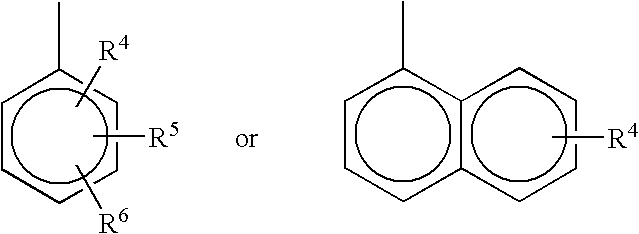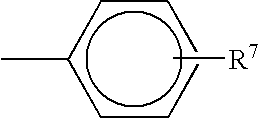Dual-wavelength positive-working radiation-sensitive elements
a radiation-sensitive element and positive-working technology, applied in the field of radiation-sensitive compositions, can solve the problems of high energy consumption, complex processing devices, and high energy consumption of highly sensitive plate materials, and achieve excellent handling properties, reduce energy consumption, and good sensitivity
- Summary
- Abstract
- Description
- Claims
- Application Information
AI Technical Summary
Benefits of technology
Problems solved by technology
Method used
Image
Examples
examples
[0136]The invention is exemplified as follows:
[0137]
Substances(Weight, %)Substance (A), Polymer 3 or 455Substance (B), o-naphthaquinonediazide2Substance (C), ADS 830A (trademark)2Substance (D), 4-hexylresorcinol20Resole resin LB 990020N,N-Diethylaniline1
[0138]The substances of the composition are dissolved in MEK: Dowanol PM™ mixture, filtered and coated on the surface of anodized aluminum. After drying the resulting precursor has a dry coating weight of ˜1.0-2.0 grams / m2. The precursor may be imaged in a Creo Lotem 400 Quantum imaging device or a THEIMER MONTAKOP 135 print down frame. The exposed precursor is developed in ˜5-10 wgt % potassium metasilicate solution in water for ˜20-60 seconds, rinsed off with water and dried to produce the printing master.
[0139]Substance (B), substance (D) and N,N-Diethylaniline are available from:[0140]Sigma-Aldrich Canada Ltd.[0141]2149 Winston Park Dr,[0142]Oakville,[0143]Ontario,[0144]L6H 6J8
[0145]ADS 830A (trademark) is available from:[0146]Am...
PUM
| Property | Measurement | Unit |
|---|---|---|
| temperature | aaaaa | aaaaa |
| temperature | aaaaa | aaaaa |
| wavelengths | aaaaa | aaaaa |
Abstract
Description
Claims
Application Information
 Login to View More
Login to View More - R&D
- Intellectual Property
- Life Sciences
- Materials
- Tech Scout
- Unparalleled Data Quality
- Higher Quality Content
- 60% Fewer Hallucinations
Browse by: Latest US Patents, China's latest patents, Technical Efficacy Thesaurus, Application Domain, Technology Topic, Popular Technical Reports.
© 2025 PatSnap. All rights reserved.Legal|Privacy policy|Modern Slavery Act Transparency Statement|Sitemap|About US| Contact US: help@patsnap.com



